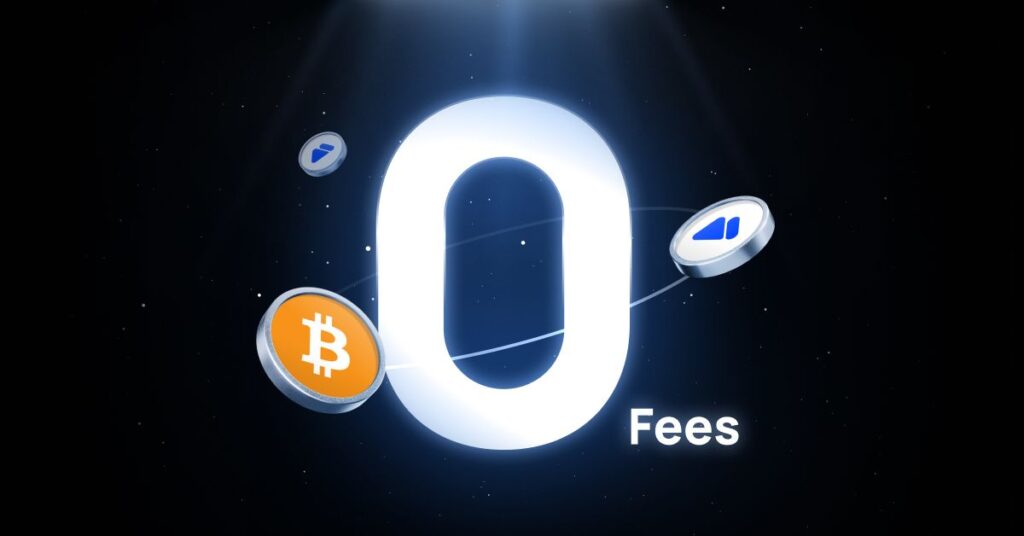
Every crypto trader—whether a curious beginner or a seasoned scalper—has one goal: to maximize returns. Yet, there’s an often-overlooked factor that chips away at those returns bit by bit: trading fees. These seemingly small costs accumulate fast, especially in volatile markets and during high-frequency trading. At MEXC, our zero fee trading model changes that equation completely.
In this article, we’ll break down how trading fees work, why they matter, and how MEXC’s zero-fee structure can benefit you—regardless of your trading experience. If you’ve ever wondered whether zero-fee trading is truly “free” or if it’s just marketing jargon, read on!
Don’t forget to learn about the latest $100 Million Guardian Fund initiative from MEXC!
What Are Crypto Trading Fees?
The Basics of Trading Fees
In every trade, there’s usually a cost—known as the trading fee—which exchanges charge as their commission for facilitating the transaction. These fees typically come in two categories:
- Maker Fee: Charged when you place a limit order that adds liquidity to the order book.
- Taker Fee: Charged when you place a market order that immediately matches with an existing order, removing liquidity.
On most centralized exchanges, maker and taker fees range between 0.1% and 0.5%. For instance, if you buy $1,000 worth of BTC and your exchange charges a 0.2% fee, you pay $2 just to execute the order. The same applies when you sell, meaning round-trip trading can cost up to $4 per $1,000.
It may not sound like much at first, but over time and volume, these fees compound significantly—especially for traders who execute frequent trades.
Real-World Impact of Fees on Your Profits
Let’s consider a few real scenarios:
- Scenario A: Daily Trading (Low Volume)
If you trade $1,000 daily at a 0.2% fee per trade, you’ll pay $2 each time. That adds up to $60 per month, or $720 per year—just in fees. - Scenario B: Scalping or Bot Trading
If you make 50 trades a day at $500 per trade, that’s 50 x $1 = $50 in daily fees, or $18,000 per year, assuming 360 active trading days. - Scenario C: Long-Term Investor Making Monthly Adjustments
Even rebalancing a $10,000 portfolio monthly at 0.1% costs $120 annually. Over five years, that’s $600 lost to fees—money that could’ve compounded.
These examples reveal a harsh truth: the more you trade, the more you lose—unless your platform offers zero fees.
What Is Zero Fee Trading?
Zero-fee trading refers to a model where users pay no trading commission on selected assets or market types. It’s a direct way to reduce trading costs and retain more profit per trade.
At MEXC, this means:
- 0% maker and taker fees on selected spot trading pairs.
- No hidden spreads, backdoor charges, or token conversion fees.
- Seamless access to high-volume pairs like BTC/USDC, XRP/USDT, and more.
Furthermore, this is an official, ongoing policy listed transparently on MEXC’s Zero Fee Page, designed to improve fairness in the trading experience.
The Evolution of Zero Fees in Crypto
Zero-fee trading is still a relatively new concept in the crypto space. Historically, fee-free models were mostly offered:
- Temporarily, as part of launch promotions.
- Conditionally, like needing to stake tokens or reach VIP levels.
- With caveats, such as wider spreads or poorer liquidity.
MEXC’s approach is different. It’s open to everyone, regardless of trading level or volume, with no token lockups or subscriptions required.
Why Does Zero-Fee Trading Matter?
1. Boosts Profit Margins Across All Strategies
With zero fees, traders can hold onto more of their gains. This is particularly powerful for:
- Scalpers, who rely on small price movements.
- Swing traders, who often enter and exit positions quickly.
- Portfolio managers, who rebalance regularly.
Even if you only improve profitability by 0.2% per trade, over hundreds of trades per year, your effective ROI increases significantly.
For instance, a trader making $10,000 in gains annually while paying $1,000 in fees improves their net profit by 10% with zero-fee trading.
2. Encourages Agile and Confident Trading
Fees often discourage traders from entering or exiting positions quickly, leading to missed opportunities or holding onto losses too long.
Zero fees give users the freedom to act decisively:
- Lock in profits without second-guessing.
- Cut losses early without cost penalties.
- Make smaller trades more often to adapt to market changes.
This flexibility is especially important in crypto markets, where hesitation can cost more than fees.
3. Level the Playing Field for Newcomers
New traders often begin with small portfolios and low confidence. Unfortunately, many exchanges charge flat minimum fees or higher percentages for lower-tier users, putting beginners at a disadvantage.
Meanwhile, MEXC’s zero-fee model:
- Removes one of the biggest barriers to entry.
- Helps new users learn by doing, without worrying about getting charged for every trade.
- Supports financial inclusivity in crypto adoption.
4. Maximizes ROI for High-Frequency and Bot Traders
Professional trading bots and high-frequency systems operate on razor-thin margins, sometimes profiting from just 0.05%–0.1% per trade.
At traditional fee rates of 0.2%–0.5%, these strategies become instantly unprofitable. Zero fee trading enables algorithmic traders to scale up operations, capture small spreads, and remain net positive over time.
How MEXC’s Zero-Fee Model Works
Unlike temporary promotions seen on other platforms, MEXC’s model is:
- Permanent for selected markets.
- Accessible to all users, with no tiers or lockups.
- Transparent, with full pair listings on MEXC Zero Fee Trading Page.
Here’s how it works:
- MEXC absorbs the operational cost of trade execution.
- Traders pay nothing in fees for the eligible pairs.
- Liquidity remains deep thanks to MEXC’s institutional market makers and user base.
Currently supported pairs include major cryptos like BTC, ETH, SOL, and others with high trading volumes. The list is regularly updated to reflect user demand and market trends.
Does Zero Fee Mean Lower Liquidity or Poor Execution?
One concern traders have when hearing “zero fee” is: Is the trading experience compromised? The assumption is that platforms offering free trades might have:
- Wider bid-ask spreads (the difference between buy and sell prices)
- Lower liquidity (leading to more slippage)
- Delayed order matching or poor execution speed
However, none of these apply to MEXC.
MEXC Maintains Top-Tier Liquidity and Speed
MEXC ranks among the top global crypto exchanges by spot trading volume, according to CoinMarketCap and CoinGecko. This isn’t just a vanity metric—it reflects deep liquidity and robust infrastructure.
Here’s how MEXC ensures top-quality execution:
- High Liquidity: Over 3,000 trading pairs with strong market maker support.
- Ultra-Low Latency: Millisecond-level trade execution engine.
- Fair Order Matching: Fully transparent and auditable.
In fact, MEXC’s zero-fee markets often show tighter spreads than fee-based competitors, because more active traders are drawn to these pairs. You can compare live spreads and volume on MEXC Spot Trading to see this in real time.
Who Benefits Most from Zero-Fee Trading?
Active Traders and Scalpers
Every cent matters when you’re trading frequently. For traders making 10, 50, or even 100 trades a day, a 0.2% fee can be the difference between net profit and net loss.
With MEXC’s zero-fee trading:
- You save thousands of dollars annually.
- Can scale strategies confidently without friction.
- Avoid VIP-tier gatekeeping seen on other platforms.
This makes MEXC a top choice for professional traders, quant funds, and algo bots.
Beginners and Low-Volume Traders
New to crypto? Then you know how frustrating it is to lose $5–$10 in fees just from buying and selling a small amount of tokens.
MEXC’s model is especially beginner-friendly because:
- You can practice real trades without burning your capital on fees.
- You don’t need to stake tokens or upgrade accounts to unlock benefits.
- It complements MEXC’s easy Buy Crypto tools and mobile app, streamlining onboarding.
For those new to trading, it’s a low-risk, high-learning environment.
Institutional and API Traders
MEXC has a growing base of API-integrated and institutional users who need both cost-efficiency and system performance. Thanks to:
- Dedicated API infrastructure
- Full spot and futures API documentation
- Competitive latency for high-frequency trading
Zero fees become a serious edge in execution cost reduction—allowing firms to focus purely on strategy and scale.
MEXC’s Zero Fee Trading Advantage vs. Other Exchanges
When comparing MEXC to other major exchanges, the cost difference becomes clear. While most platforms advertise low fees, these typically apply only after meeting certain conditions — like staking native tokens, hitting large trading volumes, or achieving VIP status. MEXC’s zero fee model is open to all users, regardless of experience level or trading size.
Here’s a quick snapshot comparing MEXC’s fee structure against other popular exchanges:
| Exchange | Spot Trading Fee (Maker/Taker) | Conditions for Lower Fees | Zero Fee Support |
| MEXC | 0% / 0% | None | ✅ Available for selected spot pairs |
| Binance | 0.10% / 0.10% | Discount with BNB or VIP tier | ❌ Not generally available |
| Coinbase | 0.40% / 0.60% | Lower rates at $10K+ volume/month | ❌ Not supported |
| Kraken | 0.16% / 0.26% | Discounts at higher tiers | ❌ No zero fee pairs |
| OKX | 0.08% / 0.10% | Requires OKB token or VIP level | ❌ Not offered on spot |
| KuCoin | 0.10% / 0.10% | Reduced with KCS staking | ❌ Not supported |
Unlike others, MEXC doesn’t lock fee reductions behind staking, token purchases, or large monthly volumes. You don’t need to jump through hoops — the savings are immediate and automatic for everyone.
This approach not only simplifies the user experience but also lowers the barrier to entry for retail and first-time traders. It reflects MEXC’s user-first philosophy and strengthens its position as a cost leader in the crypto exchange landscape.
Zero Fee Spot Trading vs. Futures and Other Costs
While spot trading on MEXC is fee-free for select pairs, it’s important to know what other fees may apply, depending on your activity:
- Futures Trading: MEXC offers very low futures fees—as low as 0.01% for makers. Learn more at the Futures Fee Page.
- Funding Rates: If you’re holding futures positions, funding rates may apply (common across all platforms).
- Deposit/Withdrawal Fees: MEXC does not charge fees on crypto deposits. Withdrawal fees vary based on the token’s network cost.
- Fiat On-Ramp Fees: Third-party payment providers may charge fees when you Buy Crypto with Card or Bank.
Even with these, MEXC remains one of the lowest-cost trading platforms in the industry overall.
How to Start Zero-Fee Trading on MEXC
Getting started with zero-fee trading on MEXC is straightforward. All you need to do is register for an account, which takes less than a minute. Once signed up, you can either deposit crypto from an external wallet or use MEXC’s Buy Crypto feature to fund your account using a debit card, bank transfer, or third-party providers.
From there, simply visit the Zero Fee Trading page to find eligible spot pairs. Major markets like BTC/USDC, TON/USDT, XRP/USDE, and many others are supported. No opt-in is needed — trades on these pairs are automatically fee-free.
For a seamless experience, MEXC’s mobile app (available on iOS and Android) offers the same access to zero fee pairs, letting you manage your trades and portfolio on the go.
Final Thoughts: Zero Fees = More Control, More Profit, More Freedom
In crypto trading, every fraction of a percent matters. While others continue to pay to play, MEXC traders enjoy a fee-free path to higher gains, better strategy execution, and full trading freedom.
Whether you’re trading $50 or $500,000, zero fee trading levels the playing field—and that’s exactly what the crypto revolution is all about.
Explore MEXC and start trading smarter today.
Join MEXC and Get up to $10,000 Bonus!
Sign Up


